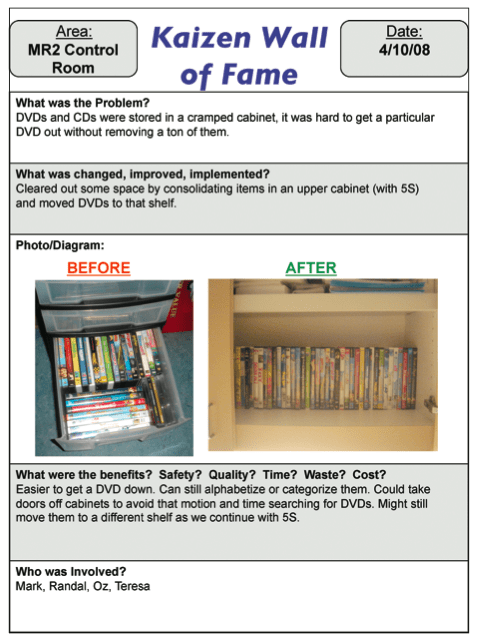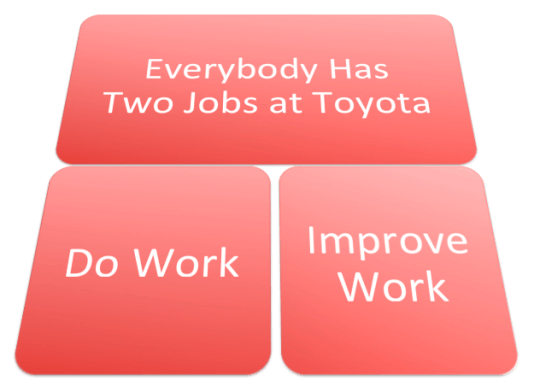Today and tomorrow, I'm attending the Lean Startup conference in San Francisco (the event produced by Eric Ries, the author of The Lean Startup). I'll be learning a lot of ideas, by attending presentations and networking, that will be applicable over at KaiNexus. I'll be taking notes in this open Google Doc.
I was accepted to give a talk about the Lean principles of continuous improvement and respect for people, as experienced in healthcare (3:40 pm in the Fairmont Hotel Crystal Room, if you're here). But, I'm also giving the talk because I hope to help spread the message that Lean, in factories, hospitals, or startups, is not just a matter of tools and techniques – it's also a culture.
I've built my presentation around my experience serving as a consultant to the MRI area of a children's hospital. I was coaching them on a Lean project that aimed to reduce the quoted outpatient MRI waiting times for patients who needed sedation (and, being children, this was most of them) from the baseline of 12 weeks. This 12 week waiting time was not good for the patients and families – and it wasn't good for the hospital since the waiting time was half that at the competing children's hospital across town.
I'll tell the story of Lara, a nurse and team member on our project, who shared her frustrations about her previous attempts at process improvement being effectively squashed by the prevailing culture of the organization that thought front-line medical staff should just do their jobs and not worry about improvement.
I'll talk about how they, within a year, reduced waiting times from 12 weeks to two weeks… and how they've sustained that performance over the five years since the project. They had the major project that looked at systemic fixes across the “value stream” – meaning the entire process from the initial scheduling request through all of the steps of the outpatient visit to the hospital to get the MRI done.
The team also used a daily Kaizen process to identify and fix dozens of smaller improvements that improved the patient experience, made work less frustrating for staff, and reduced quality problems and safety risks. Some of these examples were shared in our book Healthcare Kaizen, like this one, pictured below:

I recently checked in with the department director and was VERY happy to hear that they have sustained the two-week waiting time even here in 2013, almost six years since the initial project started. One thing they put in place was a process for charting and tracking the patient waiting times on an ongoing basis. The director said that the one time that waiting times creeped up to about four weeks, they detected that from their performance measures (that were instituted in the initial project) and they engaged staff members to figure out how to get that waiting time back down. They've also increased their MRI volume by 26% since 2008 without adding another MRI or adding more people.
It's a great story and I was glad to play a small role in it. The power of Lean is that it's a culture of both:
- continuous improvement
- respect for people
You can't have one without the other. We are driven to continuously improve because we respect our patients (and their families) and we respect our employees, physicians, and other stakeholders who want to do their best. We get sustainable continuous improvement by respecting everybody involved. Engaging people in the Kaizen process is one way we practically demonstrate “respect for people” in the workplace.
Before Toyota, there was a separation between “doing work” and “improving work.” Improving work was the responsibility of “experts” like engineers, consultants, and managers. Toyota helped create a new workplace responsibility that everybody has two jobs, as illustrated below:

Can we create the same environment in startup companies? Can we maintain that culture as a startup becomes a larger, more established company?
What do you think? Please scroll down (or click) to post a comment. Or please share the post with your thoughts on LinkedIn – and follow me or connect with me there.
Did you like this post? Make sure you don't miss a post or podcast — Subscribe to get notified about posts via email daily or weekly.
Check out my latest book, The Mistakes That Make Us: Cultivating a Culture of Learning and Innovation:










Thanks for the teaser Mark – I’m looking forward to your talk today – I’ll be interested to see how you get people enthused about making changes and how to get the change to stick. Also – do you have folks dedicated to kaizens or do they make changes on top of their ‘day job’?
Thanks, Andy. I have just 20 minutes, so we’ll maybe have to continue the discussion in person and here on the blog.
Getting people enthused about making changes — when we work on things that matter to them (meaning don’t just focus on cost cutting, but mainly on quality, safety, and patient experience), people in healthcare get very excited about that. Changes are more likely to stick when they solve real problems and when people are engaged in identifying problems and coming up with solutions to test.
Kaizen works best when everybody is involved. This means using time on an ad-hoc basis as it appears and sometimes scheduling specific Kaizen hours, as some hospitals are doing (following Toyota’s lead). I don’t think Kaizen works well when it’s left to specific people… or at least it’s not Kaizen if it’s specialists only.
[…] think my breakout session talk on continuous improvement went well. I’ll consider it a success if I hear people from startups utilizing Kaizen methods […]
Kaizen does work best when there is true teamwork, if not it will only be a waste of time. We have to make sure that the following 5 key steps are followed:
1. Identify problem
2. Identify what measures exists that are cause the process to work in such way
3. Identify your target process
4. Identify current business drivers
5. Document scope of the proposed application of Kaizen
I like your framework, Nora.
The framework Joe and I shared in our books is:
1) Find problems or opportunities
2) Discuss them within a team and with supervisor
3) Implement the idea (a small test of change)
4) Document the idea (reflection and recognition)
5) Share the idea
Thanks Nora. That is a great framework – we often dive straight in and try and solve problems without doing upfront thinking – your model helps to frame the issue and get buy in. Thanks again!
[…] “Preview of Engaging Your Team in Continuous Improvement” by Mark […]